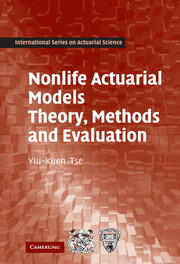5 - Ruin theory
from Part II - Risk and ruin
Published online by Cambridge University Press: 05 June 2012
Summary
We consider models for analyzing the surplus of an insurance portfolio. Suppose an insurance business begins with a start-up capital, called the initial surplus. The insurance company receives premium payments and pays claim losses. The premium payments are assumed to be coming in at a constant rate. When there are claims, losses are paid out to policy holders. Unlike the constant premium payments, losses are random and uncertain, in both timing and amount. The net surplus through time is the excess of the initial capital and aggregate premiums received over the losses paid out. The insurance business is in ruin if the surplus falls to or below zero. The main purpose of this chapter is to consider the probability of ruin as a function of time, the initial surplus and the claim distribution. Ultimate ruin refers to the situation where ruin occurs at finite time, irrespective of the time of occurrence.
We first consider the situation in which premium payments and claim losses occur at discrete time. We derive recursive formulas for the probability of ultimate ruin given the initial surplus. These recursive formulas require the value of the probability of ultimate ruin when the start-up capital is zero. Formulas for the probability of ruin before fixed finite times are also derived. To obtain bounds for the probability of ultimate ruin, we introduce Lundberg's inequality. In the continuous-time set-up, we assume the claims follow a Poisson process.
- Type
- Chapter
- Information
- Nonlife Actuarial ModelsTheory, Methods and Evaluation, pp. 143 - 168Publisher: Cambridge University PressPrint publication year: 2009

